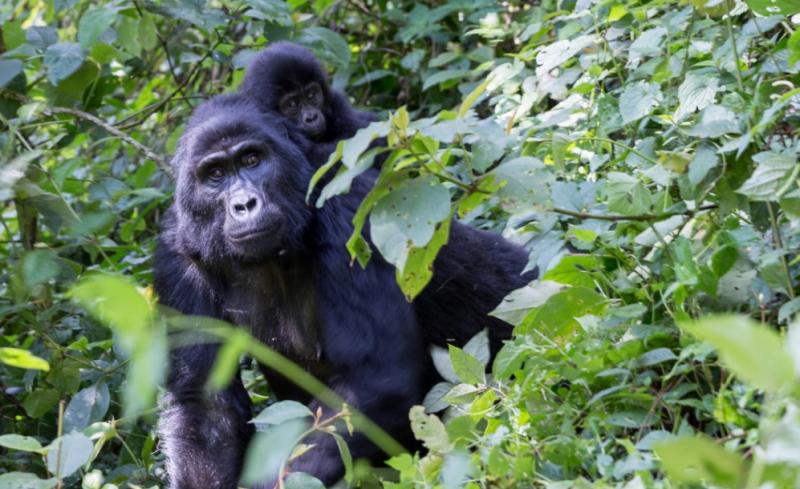
Responsible Gorilla Trekking in Uganda
Fact Box
Mountain Gorillas
Critically endangered, the mountain gorilla is a sub species of the eastern gorilla found in Central and East Africa. While large in size, they are the gentle giants of the animal kingdom and notoriously shy and will only show aggression if provoked or in danger, beating their chests and often fighting to the death to protect their young. They live in groups up to 30 called troops that are led by an older male silverback, named so due to the silver streak of hair it acquires when it reaches sexual maturity.
Size: Average height 150cm (male standing up), average weight 100kg (male)
Habitat: The extinct volcanic mountains of the Virunga Mountain range and Bwindi Impenetrable Forest. They live in areas of dense vegetation that are cloudy, misty and cool.
Fun Fact: Gorillas have the same emotions as humans and can laugh when tickled
Majestic and magical, seeing a gorilla in its natural habitat is a truly spectacular sight to behold and one of the most memorable moments of any safari experience. These striking creatures are the planet’s largest living primate and behind chimpanzees and bonobos are the closest living relatives to humans, sharing 98% of our DNA. Divided into two species, eastern gorillas and western gorillas, they are mainly found in the forests of Eastern and Central Africa and live in groups known as troops that are typically headed by the dominating silverback male. Despite being portrayed as ferocious beasts in Hollywood blockbuster King Kong, they are shy in nature and not as easy to spot in their natural habitat as other African mammals. However, there are a handful of opportunities for the discerning adventurer to trek into the depths of African forests and have the once in a lifetime opportunity to spend time in their splendid presence.
Unfortunately, as with many primates, gorillas are a critically endangered species and now there is estimated to be just over 100,000 western lowland gorillas and less than 5,000 eastern lowland gorillas left in the wild. Loss of habitat, illegal hunting, civil wars and disease have all contributed to their numbers dwindling but with increased conservation efforts these animals can be protected. Even though tourism can often have negative connotations with animal welfare with unsightly images of beaten elephants or sedated tigers lying lifelessly for the purpose of entertainment springing to mind, it is in fact tourism that has contributed to better gorilla conversation efforts. When arranging gorilla trekking with reputable tour companies, visitors are guided safely through the forests to approved areas while also being educated on the species.
When choosing where to go to catch sight of these phenomenal primates in their natural habitat, the Bwindi Impenetrable Forest in Uganda is arguably your best bet. A UNESCO World Heritage Site and home to over half of the world’s remaining population of mountain gorillas, the forest is absolutely stunning. It offers a biologically diverse landscape with volcanoes, jagged valleys, waterfalls, lakes and mountain ranges, presenting each traveller with the prospect of coming within close proximity to one of nature’s greatest spectacles.
The gorillas that you’ll encounter in the Bwindi Impenetrable Forest are mountain gorillas, whose conservation status was brought to public attention following American primatologist and conservationist Dian Fossey’s extensive research on the species, documented in her book Gorillas in the Mist, which wassubsequently made into an Oscar-nominated film. This particular sub-species of the eastern gorilla is characterised by its thicker and longer fur and in addition to living in the Bwindi Impenetrable Forest, their other habitat is the Virunga Mountains which straddle Rwanda, Democratic Republic of the Congo and Uganda. In 2016, it was estimated that there was only 880 of them left in the wild.
While gorillas are social amongst their own kind they are also incredibly shy and the process for them to become comfortable in the presence of humans, known as habituation, can take up to five years. Rangers and conservationists alike spend time getting closer and closer to a gorilla family until eventually they arrive at a stage where they are at ease around humans. Over the past 25 years, the number of gorilla families that are habituated to humans in the Bwindi Impenetrable Forest has increased from just one in 1995 to 15 currently. There has also been a recent baby boom which is expected to prove positive for the gorilla census being carried out later this year, with numbers expected to rise from the estimated 400 gorillas recorded in the last census in 2011.
The journey to reach them is challenging and can be physically demanding taking anything from three to nine hours, depending on where the gorilla families are that day and therefore requires an adequate level of fitness. Nevertheless, the reward of tackling this trek is incomparable as you will be gifted with spending one magical hour in their awe-inspiring presence. Never has the phrase ‘quality over quantity’ rung so true. Although sighting gorillas is the primary objective, the forest itself is magnificent. Its vegetation is ancient and it is home to a range of other fascinating animals including forest elephants, baboons and chimpanzees as well as a dazzling array of bird life.
Practical Info:
There are specific rules that you will be required to follow to ensure that not only will you get the most out of this experience but that the gorillas’ best interests are at the forefront of any trekking venture. All treks are led in small groups and visitors will be advised to keep their distance, not to eat or drink in front of the gorillas and only spend a maximum of one hour in their company. Gorillas are also susceptible to disease, so if you are ill you may even be refused entry to the park. Gorillas can be sighted all year round, therefore there is no optimum time to come but do bear in mind that Uganda is characterised by two wet seasons: March-May and October-November, which can make trekking more strenuous. A popular time to visit is during the dry season of May-September, but as the forest is located along the equator it is difficult to predict the conditions.
Getting to the Forest:
The main entry into Uganda is to by flight into Entebbe International Airport, situated near Entebbe town and 25 miles away from capital city Kampala. Once in the country, Fly Uganda and Aerolink operate a number of domestic flights to most of the country’s National Parks. Bwindi Impenetrable National Forest is well served by several smaller airports such as Kihihi and Kisoro. UK and US citizens will need to apply for a Ugandan or East African Tourist Visa before entering the country.
Share this article:



















